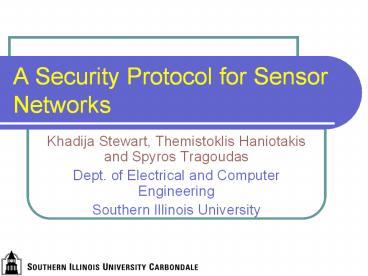A%20Security%20Protocol%20for%20Sensor%20Networks - PowerPoint PPT Presentation
Title:
A%20Security%20Protocol%20for%20Sensor%20Networks
Description:
A Security Protocol for Sensor Networks Khadija Stewart, Themistoklis Haniotakis and Spyros Tragoudas Dept. of Electrical and Computer Engineering – PowerPoint PPT presentation
Number of Views:162
Avg rating:3.0/5.0
Title: A%20Security%20Protocol%20for%20Sensor%20Networks
1
A Security Protocol for Sensor Networks
- Khadija Stewart, Themistoklis Haniotakis and
Spyros Tragoudas - Dept. of Electrical and Computer Engineering
- Southern Illinois University
2
Outline
- Abstract
- Previous work
- Proposed method
- Uncorrelating the bits
- Encryption scheme
- Reverse uncorrelation and decryption scheme
- Hardware overhead
- Experimental results
- Conclusions
3
Abstract
- Sensor networks are extensively used in military
and rescue operations - Need for secure communications
- Memory, computational and energy resource
constraints - Security protocol must use minimal resources
- Available security schemes are either
inefficient or expensive
4
Previous Work
- Key based schemes
- Frankel et al 1989
- Eshenaur et al 2002
- Chan et al 2003
- Liu et al 2003
- Du et al 2005
5
Previous Work
- Keyless methods target flexibility
- Rabin 1989
- Papadimitratos et al 2003
6
Proposed Method Outline
- Message split into 2n sub-messages
- Sub-messages uncorrelated using an LFSR
- Sub-messages encrypted
- Encrypted sub-messages are routed through
transmission disjoint routes - At the destination, sub-messages are decrypted
and uncorrelation is reversed
7
Proposed Method Splitting of the message
a0 a1 a2 a3 a4 a5 a6 a7 a8 a9 a10 a11
Number of columns of array B Number of node
disjoint paths
b0,0(a0) b0,1(a1) b0,2(a2) b0,3(a3)
b1,0(a4) b1,1(a5) b1,2(a6) b1,3(a7)
b2,0(a8) b2,1(a9) b2,2(a10) b2,3(a11)
8
Proposed Method Uncorrelating the bits
- LFSRs primarily used in circuit testing to
produce pseudo-random patterns - A different LFSR chosen for each sub-message i
- Characteristic polynomial and ti are encoded and
appended to the outgoing sub-message
011 001 100 010 101 110 111
Example of an LFSR with k 3 and T 7
9
Proposed Method Encryption Scheme
- For i0 to m-1
- Xi bi,0 XOR bi,1 XORXOR bi,2n-1
- For i0 to m-1
- For j0 to 2n-1
- Ci,j Xi XOR bi,j
10
Proposed Method
- Sub-messages are routed through node disjoint
routes - Routes only need to be node disjoint due to the
use of directional antennas - A mote can overhear transmission if and only if
it is within transmission range and in angular
span of sending node
11
Proposed Method De-uncorrelation and
decryption Scheme
- Procedure decode
- For i0 to m-1
- Xi ci,0 XOR ci,1 XORXOR ci,2n-1
- For i0 to m-1
- For j0 to 2n-1
- bi,j Xi XOR ci,j
- Sub-messages reverse uncorrelated in a similarly
designed LFSR
12
Hardware Overhead
- The hardware requirements are
- An m bit LFSR
- Two levels of XOR gates
- One level is used for encryption and the other is
used with the LFSR - Three levels of multiplexers
- 2x1 multiplexers at the inputs of XOR gates
- 4nx2n multiplexers to initiate LFSR
13
Experimental Results Area and power
requirements
- Power consumption of RSA chip is in the order of
500 mW - Power and area of ECC module is over 300 mW and
24,000 square microns - Security module designed and synthesized in VHDL
for a 512 bit ckt - Power consumption 5 micro Watts
- Area less than 25 square microns
14
Experimental Results Performance measurements
using OPNET
- Experiments conducted on networks of 60, 70, 80,
90 and 100 motes with 90 degree directional
antennas - Wireless transmission range set to 25 meters
15
Experimental Results One intruder
- Experiments ran 10 times for each network size.
In each run, a random node chosen as intruder - Number of paths maximum even number of node
disjoint paths - Used destinations at least two hops away
- No single intruder node was able to intercept
a complete message
16
Experimental Results Multiple intruders
- 70 motes
intruders of disjoint paths of disjoint paths of disjoint paths of disjoint paths
intruders 2 4 6 max
2 6 3 0 0
4 8 6 2 1
6 10 8 4 2
8 12 8 6 2
Percentage of messages intercepted for different
numbers of paths
As the number of paths increases, the number of
intercepted messages decreases
17
Experimental Results Performance of scheme in
presence of several intruders
motes paths intruders intruders intruders intruders intruders
motes paths 2 4 6 8 10
60 4 0 2 4 4 4
70 6 0 1 2 2 4
80 8 0 1 3 3 4
90 10 0 1 2 2 3
100 12 0 1 2 2 3
Percentage of messages intercepted in the
presence of different numbers of collaborating
nodes
Low interception rates even for large number of
intruders
18
Conclusions
- An encryption method and uncorrelation scheme for
secure message transmission in sensor networks - Experimental results show
- Low resource requirements of proposed method
- Efficiency of proposed method in protecting
secrecy of messages
19
Questions?
- Thank you































